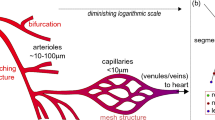Abstract
Two models of optimal branching structure of the vascular tree are compared. Murray’s minimum work model derived from minimum energy loss due to flow and volume in the duct system is proved to be included as a mathematical group in the authors’ model defined by the minimum volume under determinant pressure, flow and position at the terminals. The problem about heterotypical trees which are identical at the terminal conditions but different in the topological order of branch combinations are discussed, applying the results of analyses on the equivalent duct of uniform terminal pressure trees. It is proved that the minimum work tree has the least energy loss compared with its heterotypical minimum volume trees and is a better model of branching structure of the vascular tree.
Similar content being viewed by others
Literature
Kamiya, A. and T. Togawa. 1972. “Optimal Branching Structure of the Vascular Tree.”Bull. Math. Biophysics,34, 431–438.
Murray, C. D., 1926a. “The Physiological Principle of Minimum Work: I.”Proc. Nat. Acad. Sci.,12, 204–214.
— 1926b. “The Physiological Principle of Minimum Work: II.”Ibid.,,12, 299–304.
Rosen, R. 1967.Optimality Principle in Biology. London: Butterworths, pp. 41–60.
Author information
Authors and Affiliations
Rights and permissions
About this article
Cite this article
Kamiya, A., Togawa, T. & Yamamoto, A. Theoretical relationship between the optimal models of the vascular tree. Bltn Mathcal Biology 36, 311–323 (1974). https://doi.org/10.1007/BF02461331
Received:
Issue Date:
DOI: https://doi.org/10.1007/BF02461331




